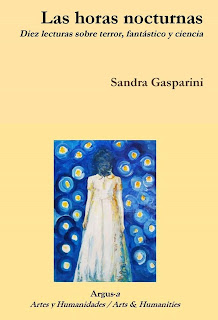IIustración de tapa: La rebelión del ánima, gentileza de Gisela Aguilar.
 Las horas nocturnas. Diez lecturas sobre terror, fantástico y ciencia propone pensar la narrativa argentina del siglo XIX y del entresiglo XX-XXI -con algunos saltos que llevan a leer a algunos autores sudamericanos- a partir de las coordenadas del fantástico y del terror, en la intersección del gótico en sus dimensiones más diversas: sus tropos recuperados, su poder simplificador y a su vez multiplicador, su conexión con lo global.
Las horas nocturnas. Diez lecturas sobre terror, fantástico y ciencia propone pensar la narrativa argentina del siglo XIX y del entresiglo XX-XXI -con algunos saltos que llevan a leer a algunos autores sudamericanos- a partir de las coordenadas del fantástico y del terror, en la intersección del gótico en sus dimensiones más diversas: sus tropos recuperados, su poder simplificador y a su vez multiplicador, su conexión con lo global.
El libro está dividido en dos partes. En la primera, se desarrollan cuatro lecturas sobre narrativas del siglo XIX en las que la razón, la ciencia y el orden patriarcal se enfrentan a lo irracional, al caos, lo sobrenatural o lo inexplicable (Sarmiento, Gorriti, Holmberg, Torres y Quiroga, Monsalve, Arana, Miralles). En la segunda, integrada por otras seis, el anclaje es mayormente espacial y vinculado a la memoria histórica (Partnoy, Alcoba, Enriquez, Feijoó, Levrero, Schweblin, narrativa Z, Laiseca, Aira, Ávalos Blacha, Bruzzone, Néspolo, Gamerro, Falco, Lamberti, Quirós, Novek y muchos más). En ambas, una delgada línea atraviesa los temores, los terrores, los horrores: la certeza de que tienen una raíz política, en tanto entran en juego el ejercicio del biopoder, las desigualdades de clase, género, etnia, las distopías que definen un ethos y auguran futuros sombríos ansiosos del fin de un orden.
Abstract
Las horas nocturnas. Diez lecturas sobre terror, fantástico y ciencia is a book about Argentine narrative of the 19th century and the end of 20th and early 21th - with some links to a few South American authors-. The proposal is to think this literature from the axis of the fantastic and the terror, at the intersection of the Gothic in its most diversity: its recovered tropes, its simplifying and also multiplier power, its connection with the global.
The book is divided in two parts. In the first, four readings about nineteenth-century narratives are developed, in which reason, science and the patriarchal order confront the irrational, chaos, the supernatural or the unexplained (Sarmiento, Gorriti, Holmberg, Torres and Quiroga, Monsalve, Arana, Miralles). In the second, consisting of six others, there is a mostly spatial anchoring and it is linked to historical memory (Partnoy, Alcoba, Enriquez, Feijoó, Levrero, Schweblin, Z narrative, Laiseca, Aira, Ávalos Blacha, Bruzzone, Néspolo, Gamerro, Falco , Lamberti, Quirós, Novek and many others). In both, a thin line goes through fears, terrors, horrors: the certitude that they have a political root, mainly when the exercise of biopower, class inequalities, gender, ethnicity and dystopia come into play, and they defines an ethos and predicts gloomy futures eager for the end of an order.


